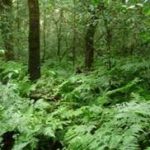TREE LIFE
November 2018
MASHONALAND CALENDAR
Saturday 3rd November: Botanic Garden walk. Meet in the car park at 8.30am. The walk at this interesting time of year, when everything is growing again, should last about an hour and a half.
Please note there is no 3rd Sunday outing in November as members are away in the Vumba.
Saturday 24th November: Greystone Park Nature Reserve. We will meet there at 14.30. There will be a car guard in attendance.
PLANTED TREES OF HARARE Anthocleista grandiflora
Family: Gentianaceae. Common names: Forest Fever tree, Big-leaf Fever tree, Forest Big-leaf, Tobacco tree.
Anthocleista grandiflora is a medium to tall (five to 35m) evergreen tree, with a smooth, straight, slender light grey or brown trunk, branching high up the trunk. Trees have long bare branches arching upward with leaves densely clustered at the ends, forming a rounded, spreading crown.
This species has large, stiff, leathery simple leaves that measure on average 150-700mm long and 70-250mm wide, although some leaves can reach up to 1.35m long and 0.5m wide. The largest leaves are found on young trees or on low-level branches. The leaves are paddle-shaped, oblong, broader in the upper half and narrowing towards the base. They are the largest simple leaves of any tree in southern Africa.
Flowers are borne in branched terminal fragrant clusters, creamy-white with a green tube, turning yellow then brown with age. The corolla tube is up to 35mm long, with eight to 13 narrow spreading petals. A crown-like ring of joined stamens at the mouth of the corolla tube surrounds the fleshy green rounded stigma. The fruit is a fleshy, smooth, oval to egg-shaped green berry, soft and yellowish
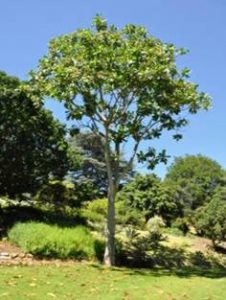
Anthocleista grandiflora. PlantzAfrica.com
brown when mature, up to 30mm long, containing many small dark brown seeds. In their own habitat, trees flower in spring-summer (from September to January) and fruit from late summer into winter (January to June).
Anthocleista grandiflora occurs in forest and along forest margins, in kloofs, beside densely wooded streams, in patches of relict forest on hillsides and in open swampy places. It is found in tropical and subtropical areas in East Africa, from Uganda and Kenya southwards to Zimbabwe, Mozambique, Swaziland, and South Africa where it is found in Limpopo and Mpumalanga Provinces. It also occurs in the Comore Islands and Zanzibar. It is common in medium to low altitude forest in mountainous regions with high rainfall, from sea level to 2300m altitude. In Harare it is most commonly seen as a garden tree and there are magnificent specimens in the Botanic Gardens.
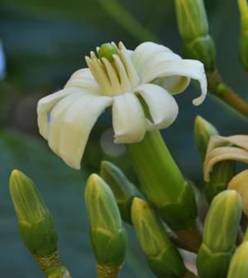
Anthocleista grandiflora flowers. PlantzAfrica.com
The name Anthocleista is derived from the Greek anthos, meaning flower, and cleistos, meaning closed or shut up. This could refer to how the stamens with their joined filaments form a ring around the mouth of the corolla tube, closing it off, or it could refer to the fact that only a few flowers of the inflorescence are open at any time, so most of the flowers are still closed buds. The specific epithet, grandiflora means large flowered, from the Latin grandis, meaning large, and floreo, to flower. However, the most obvious feature of this tree is the large leaves so one wonders why it was not called grandifolia! The common name of Forest Big Leaf is self-explanatory and the name Tobacco tree refers to the superficial resemblance of the leaves to those of tobacco plants. This species is also called Forest Fever tree on account of it being used to treat malaria.
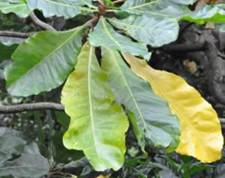
Anthocleista grandiflora leaves. PlantzAfrica.com
The genus Anthocleista is a small genus of about 15 species of trees found mostly in tropical Africa, Madagascar and the Mascarene Islands. Anthocleista grandiflora is the only species found in southern Africa. In its natural habitat elephants eat the leaves and branches, while birds, monkeys and fruit bats eat the fruits on the tree and bush pig eat the fruits that fall. Many different insects are attracted by the flowers and many insect-eating birds are, in turn, attracted by these insects.
The tree has many medicinal uses: in South Africa the leaves and bark are used to brew a tea to treat malaria while bark is chewed to treat diarrhoea, diabetes, high blood pressure and venereal disease. In the Congo the leaf and leaf ash is used to treat wounds of teats. In Tanzania leaves are used to treat malaria and roots to treat diarrhoea. In Zimbabwe the bark is used to treat epilepsy while in Madagascar it is used to treat diarrhoea, fever and hepatitis. The leaves are used as a tonic, but are laxative in large doses. The smoke of burning bark is inhaled to dispel bad spirits, and pieces of root are braided into the hair as a lucky charm. In vitro tests have shown the leaf extract to have significant activity against the bacteria Staphylococcus aureus, Bacillus subtilis and Pseudomonas aeruginosa, but show no significant anti-malarial activity.
The wood is whitish yellow, light, soft and easy to saw and work. It finishes and polishes well, but is brittle, not durable and attacked by termites, and is thus useless for anything but light construction, short-lived items or for crates, boxes, or firewood.
Extracted from an article by Alice Notten,
Kirstenbosch National Botanic Garden March 2014.
Source: PlantzAfrica.com
-Tony Alegria
OUTING TO THE BOTANIC GARDENS 6th OCTOBER 2018
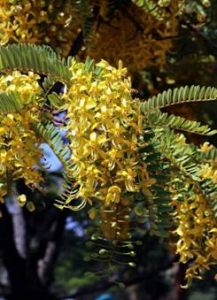
Cassia ferruginea – Photo Mark Hyde
We set out to look for trees that were flowering and first of all found a tree with pea shaped purple flowers – Trachylobium verrucosum. Zanzibar Copal tree.
We then deviated a bit to look at the compound thorns of what looked like a Flacourtia species (below).
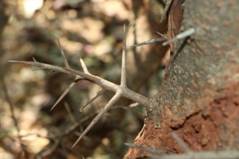
Flacourtia species – Photo Mark Hyde
Unfortunately the Fernandoa abbreviata which had looked so spectacular the previous month now only had one or two flowers. Next we found Millettia dura whose flowers hang down differently to Millettia grandis, whose flower spikes point upwards. We then had a quick look at a Philenoptera violacea and Cordyla africana before we found the most unusual flowers of the Cladostemon kirkii – Three-finger bush. This is a lowland tree growing mostly in Mozambique but is also to be found in the Eastern lowlands of Zimbabwe.
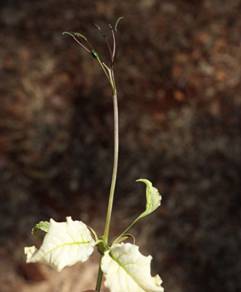
Cladostemon kirkii flower – Photo Mark Hyde
After that, we did a bit of a march to see a couple of trees which were located beyond the Herbarium. Here we found an Indian tree, Saraca osoca and a really spectacular Brazilian tree – Cassia ferruginea – which was densely covered in yellow flowers.
On the way back we noticed that the Tabebuia heterophylla had finished flowering but that the Tabebuia heptaphylla was now covered in pink flowers. There were only two flowers to be seen between the two Stereospermum kunthianum, the Pink Jacarandas.
Time was up and we then had to leave the party of 10 to attend a committee meeting.
-Tony Alegria
FIRESTORMS IN SAVANNA AND FOREST ECOSYSTEMS (adapted from Tree Life 370 June 2011)
On the morning of 13 September 2008, the undulating landscape of Hluhluwe Game Reserve in Kwazulu-Natal, South Africa, was a rolling patchwork of green, dense forests and the pale yellows and browns of winter grasses. But over the next 48 hours the hills of Hluhluwe were transformed and areas dominated by thickets and forests were diminished essentially overnight, opening the landscape for sun-loving grasses to invade. The land singed and black, all bush removed, smouldering. Over a few days, the ashy black was replaced with the stark green of new growth. From forest to grassland: a shocking natural transition brought about by just one catastrophic event – a fierce firestorm.
Despite the terrible aura of destruction, fire is a necessary and vital driver within savanna ecosystems. Grasses and forests have long coexisted and natural fires have been sweeping through the African landscape for millions of years, fine-tuning the mosaic of these fundamentally incompatible communities. Grasslands depend upon these fires for regeneration, while they are destructive to forests. But forests usually survive grass fires with only their margins singed. However, the way in which fire patterns the landscape needs be better understood, because everything is changing…
Globally, and in South Africa, the effects of climate change on our ecosystems are quite noticeable. A risky trio of changing rainfall patterns, rising air temperatures and low humidity has resulted in extreme fire weather with widespread increases in forest flammability and subsequent large-scale fire events. Over the past decade extreme fire weather patterns have generally increased in frequency, size and intensity to levels beyond those historically experienced. If this is the case now, what then might the future hold? In the face of climate unpredictability, how do we foresee, prepare for, utilize, and manage these events during the fire season?
From a grassland perspective: While it is tempting to focus on the shock of destruction caused by extreme fire events, they can also be recognised as positive agents that can be used to tackle the worrying colonisation of grassland systems by advancing indigenous woody vegetation, called ‘bush encroachment’. And bush encroachment is on the rise. In the face of the new climate regime, woody plant cover is promoted as never before in the history of savanna landscapes. Why? Because present carbon dioxide (CO2) levels in the atmosphere are higher now than they have been for at least one million years and C02 acts like a steroid for the growth of woody plants. What results is a shift in the grass-tree balance with woody plants gaining increasingly over savanna grasses, which have evolved under lower C02 conditions. Left unchecked, what we may witness is the loss of our grassland and savanna biomes to advancing scrub woodland. Firestorms could be the best way to reverse this.
From a forest perspective: Forest ecologists, however, have thrown another spanner into the works. Many have raised concerns about the threat that grass-fuelled fires might pose to forests and the biodiversity they support. Forest-grassland mosaics exist because, although grasslands can burn very frequently, fires do not usually penetrate forests. Typically these fires require a continuous supply of grass fuel for the fires to spread and forests shade out the grasses. But if the ‘rules’ change, and grassland fires begin to enter and burn forests more frequently, then forests may be eliminated.
For the last half century and more in Hluhluwe Game Reserve, forests have had the upper hand. Major bush encroachment has engulfed the grasslands, despite frequent fires and the activities of elephants and many other browsers (such as Impala, Nyala, Black Rhino, Kudu, Bushbuck and Giraffe). However, with the coming of this catastrophic fire, decades of scrub woodland invasion of grasslands was reversed in a single day. In September 2008 a very severe fire burnt right through the newly formed thickets and a forest section in the park, completely destroying the forest structure. This was a novel situation that challenged what we know. Typically fires do not penetrate beyond the edges of the forest and thicket stands. What was the cause of this firestorm? And, as always the burning question is ‘how did it happen’?
One possible answer was that the reserve had been heavily infested with Chromolaena odorata, an invasive pest in the park that belongs to the sunflower family and hails from North and Central America. The plant is more flammable than the scrub woodland species it replaces, while piles of dried, felled Chromolaena would provide a ready fuel-bed. However alien plant clearing teams at Hluhluwe have done a remarkable job in removing Chromolaena and we could find no evidence to show that either old cleared areas, or areas yet to be cleared, had burnt any more fiercely than uninvaded areas.
So if not the fuel, then how about the weather preceding the fire? The big fires in California, Greece and Australia in the last few years were preceded by long, hot droughts – ideal conditions for high intensity wildfires that burn down forests. Yet the 2008 Hluhluwe firestorm was preceded by an average rainfall season, not particularly hot, nor dry. Indeed the fire danger index used by plantation foresters nearby showed nothing unusual in the days preceding the fire.
Switched on for fire? In growing frustration, we turned to an idea first suggested by Australian colleagues. Imagine a set of switches – to get a ship or a plane moving, all those switches need to be on. Well fire, they suggest, is the same – all switches need to be on and then there is nothing stopping the firestorm. If any switch is off, it will be an ‘ordinary’ fire (or no fire at all). So if this is correct, what are the switches for a severe fire event? The Working on Fire teams in South Africa have identified something memorable, called the 303 rule — ‘thirty, thirty, thirty conditions’. This means air temperature greater than 30°C, relative humidity less than 30% and wind speed greater than 30 km/hour. Fires that occur during these conditions cannot be contained. Any sensible person would go swimming. You can imagine the other key switches: there must be enough grass to fuel the fire, the grasses should be dry, and you need a match. Well, there was plenty of grass, it was bone dry at the end of winter, and an arsonist provided the match. And our detailed weather station data showed that 303 conditions continued for hour after hour on the day of the firestorm. All switches were on!
The unnerving thing is that, unlike the big fires of Australia, Greece and the USA, the extreme weather conditions appeared overnight and without any prolonged build-up. Analysis of the climate data from our weather station at Hluhluwe from 2001-2008 showed that the alignment of all three switches to produce 303 weather conditions is very rare. It is even rarer if the fuel switches are included. And then you need the final switch of the fool with the match.
Or is it that foolish? Thicket and forest patches that developed and expanded over decades were changed in composition and structure over 48 hours. Was this event desirable or undesirable? The fire was desirable from the point of view of reducing bush encroachment, but undesirable due to the loss of forest and the biodiversity it supported. This fire created the potential for a system switch, allowing the return of savanna through the spread of savanna grasses into the now open, sunlit landscape.
Should we throw that final switch sometimes?
Preliminary data from this study in Hluhluwe suggests that burning the veld under weather conditions conducive to severe fires, the 303 phenomenon, provides an opportunity for managers to reclaim invaded grasslands by opening up densely wooded areas. There are, of course, major safety issues, such as good fire training, equipment and manpower that need to be taken into account before firestorms can be effectively and safely emulated.
Through understanding the causes of such an extreme fire event such as that of Hluhluwe in 2008, managers in the future could either ignite fires under extreme conditions to help savannas recover from bush encroachment, or be under high alert when extreme conditions arise. As far as we know this is the first South African study characterising the climatic and other conditions causing grass-fuelled firestorms capable of burning into forested areas. The onset of 303 conditions, when a mild fire is already burning, may be important to understanding the dynamics of these severe fire events. The ability to predict firestorms, and their consequences in the future could be improved by furthering our understanding of the dynamics of flammable connectivity and the relationships between fire switches.
We wonder whether similar extreme weather events might account for the very damaging fires that have occurred in South Africa in the last few years where losses of lives (of both people and livestock) and destruction of infrastructure and property have been devastating. Our interest is ablaze and several burning questions remain unsolved. We are particularly interested to see whether the 303 rule has any wider relevance as a marker of extreme fires. As an early warning signal, it seems essential to identify synoptic conditions that best predict the onset of firestorm weather.
No doubt different land-users will have different attitudes to firestorms. In the Hluhluwe context, we argue that they provide an excellent opportunity to turn back the tide of scrub woodland invasion of the grassy biomes. But if firestorms become the norm in our globally warmed future, they would be disastrous for our indigenous forests. Regardless of their ecological effects, these are extremely dangerous phenomena and we salute the Working on Fire teams for identifying the weather conditions and for their skill in managing the fires.
– Catherine Browne & William Bond UCT
[Global Climate Change is having a similarly drying effect on Zimbabwean vegetation and the risk of fire increases with time. Of course the fire situation described above only applies to protected areas. In Zimbabwe now because of the lack of commercial farmers on the ground to fight the fires on their lands, most of the bush in these areas is burnt annually – Ed]
TONY ALEGRIA CHAIRMAN



